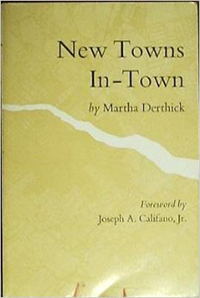Derthick, Martha. New Towns In-Town: Why a Federal Program Failed. Washington, D.C.: Urban Institute Press, 1972.
“New Towns in-Town . . . chronicled the demise of a federal program to build model new communities on surplus federal land—socially and racially mixed, beacons of hope amid the urban tumult and inner-city squalor of the riot-torn Sixties. The idea for the New Towns initiative came from President Johnson himself, White House staffers and the relevant federal agencies responded with alacrity to his command, and one might have anticipated the speedy realization of LBJ’s attractive vision, especially in the immediate aftermath of the worst of the Long Hot Summers (New Towns was promulgated in the fall of 1967). Three years later, however, the program was almost dead: three out of seven projects had been abandoned, the others were moribund. What had gone wrong? First, the concept had not arisen from any deliberative process; instead, it had been unveiled in a press release, and only then had federal agencies and local communities scrambled to figure out how it might work. Second, at that point all sorts of barriers to success appeared: differences among federal agencies; skepticism from powerful, home-town legislators; community opposition. More broadly, this sad episode illuminated for Derthick the hubris of the Great Society—the way that it had raised expectations, made vast promises in response to social problems that in truth were both intellectually intractable, and hard to impose in the federal context of American democracy. Washington ‘cannot ‘create community’” was her bleak conclusion; it ‘cannot prescribe the grounds on which people will come to sense that they have enough in common to live together as neighbors.’”
Online:
Amazon

